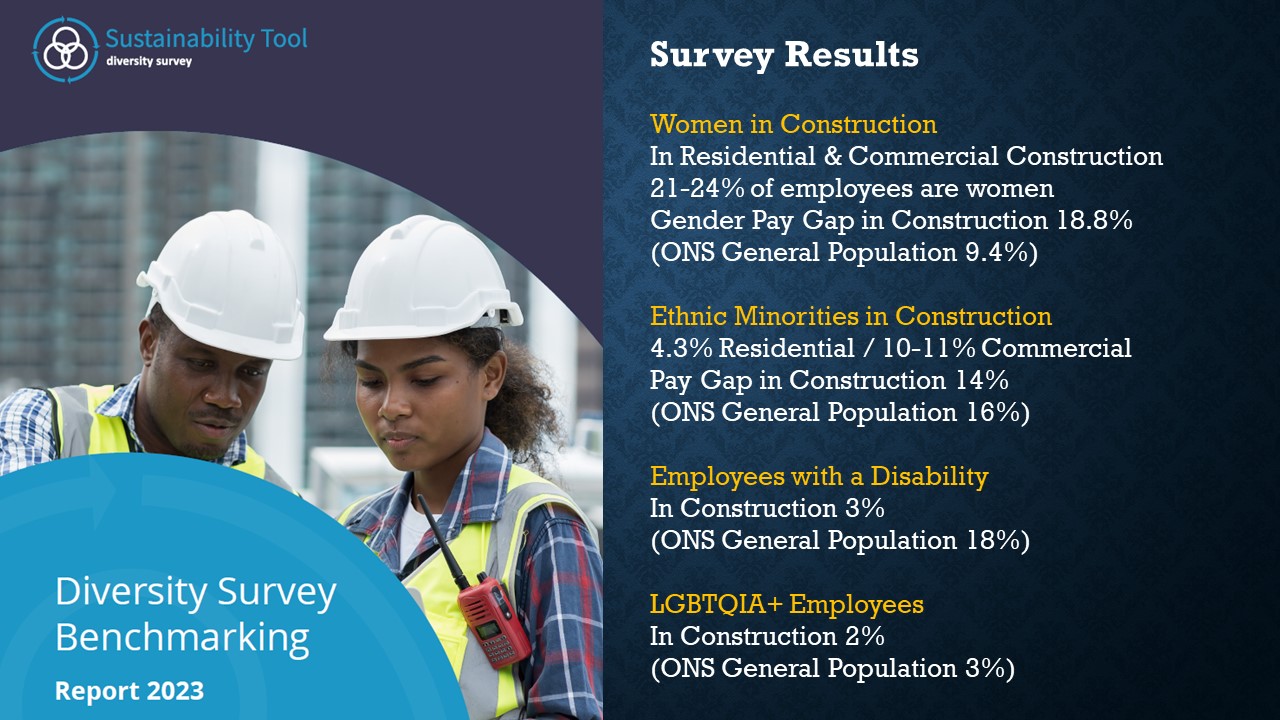
Diversity in Construction in 2023
In January 2024, the Sustainability Tool, in collaboration with the Supply Chain Sustainability School’s Fairness, Inclusion and Respect (FIR) Programme, published its UK built environment diversity survey. This survey provides a detailed record of diversity data and pinpoints areas for improvement.
The survey suggests that although there has been some positive progress on attracting, employing and retaining women in the industry, pay gaps are still too wide and much still needs to be done to improve prospects for ethnic minorities, those with disabilities and those in the LGBTQAI+ community.
537 organisations reported their data in 2023 covering 526,415 employees. Of these, 382 organisations (~71%) were SMEs covering around 13% of the employees (~68K), with the other 87% coming from Tier 1 companies.
The organisations were also surveyed about voluntary leavers from their organisation in 2022. The data included 40,000 voluntary leavers from 166 organisations.
Although it is not specified in the report, it seems likely that the survey only includes those directly employed by organisations within the built environment sector. The ONS (Office for National Statistics) states that self-employed jobs in the construction sector accounts for 16.7% of the work force (the highest level of self-employed jobs across the whole economy). This means that self-employed tradespeople and micro-SMEs who make up a large proportion of those working in the industry are excluded from the results.
Women in Construction
The survey reported an increase of 6% in the percentage of women employed in the built environment sector to 29.1% in 2023. This is definitely a move in the right direction and probably reflects the efforts of the construction industry to attract more women.
However, the figure is lower in the Residential & Commercial Construction sectors, occupied by SC4 Carpenters, where only 21-24% of employees are women.
The Gender Pay Gap in Construction is 18.8% compared with the general population gap of 9.4%.
Women in the industry tend to be more prevalent in the younger age groups.
Despite the increased efforts of the industry, the survey stated that only 25% of job applicants are women, however women have the best hire rate of all sectors measured with a ratio of 1 hire to every 24.8 applicants compared with a ratio of 1 in 33 for men.
Attracting women as skilled tradespeople has been less successful. Just 1% of all skilled trades professionals working in the UK construction sector – such as joiners, bricklayers, electricians, plumbers, and carpenters – are women, according to the latest ONS figures.
Ethnic Minorities in Construction
The survey suggests that attracting ethnic minority applicants to the industry is not a problem as they make up 52.5% of the total applications. This figure should support the industry in increasing ethnic minority group representation, with the aim of moving towards the ONS’ figure of 18.5%. However the survey found that only 1 out of every 90 applicants from an ethnic minority background is hired. In contrast, 1 out of every 28 applicants from a white background is hired.
The survey found that Ethnic Minorities make up just 4.3% of employees in Residential Construction, 10-11% in Commercial Construction and 13.6% in all the Built Environment industries surveyed. ONS reports that Ethnic Minorities make up 18.5% of the population.
The survey also reports an Ethnic Minority Pay Gap in Construction 14% compared with ONS Pay Gap in the general population of 16%.
Worryingly, according to the survey, 20% of construction voluntary leavers are from ethnic minority groups, hence ethnic minority groups are being lost at a larger % than are being employed.
Employees with a Disability in Construction
According to this survey, only 3.6% of people working in the built environment have a disability, compared with 18% in the general population (ONS). It also found that people with a disability are being lost at a higher rate than their representation in the industry for 2023.
LGBTQIA+ Employees in Construction
Only 2% of the employees listed in the survey described themselves as being in the LGBTQIA+ community compared with 3% in the general population (ONS). The survey reported that people in the LGBTQIA+ community are also being lost at a higher rate than their representation in the industry for 2023.
Click on the categories below to find out more about:

Connect with Us
Share this Page
More Posts
Recent Posts
- Breathe Easy, Work Safe: The RPE Every Site Worker Needs
- From Site to Strategy: Simon Mead Promoted to Associate Director at SC4
- SC4 named Cala Contractor of the Month, October 2025
- Why is Neurodiversity so important in Construction?
- Our Favourite Carpentry Project Of 2024: Cromwell Court, Old Basing
- Case Study: Timber Frame Installation in Netley Grange, Southampton